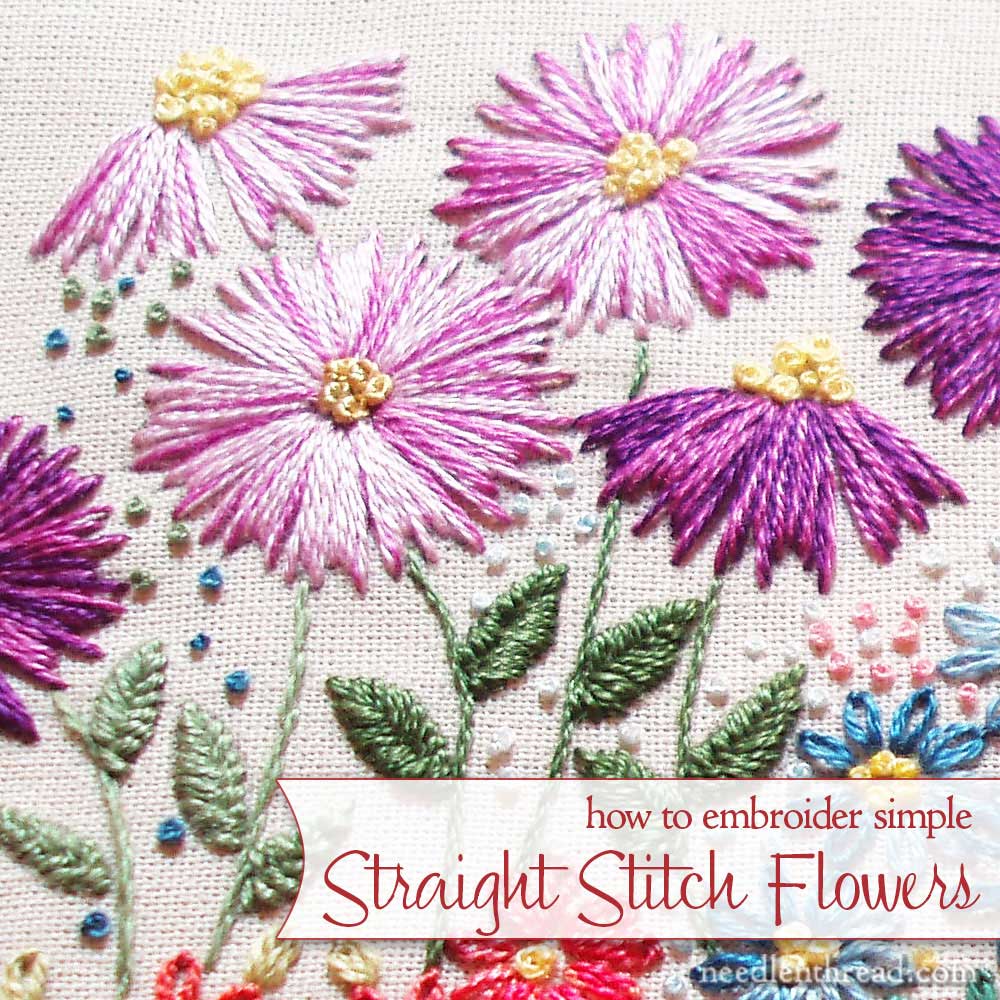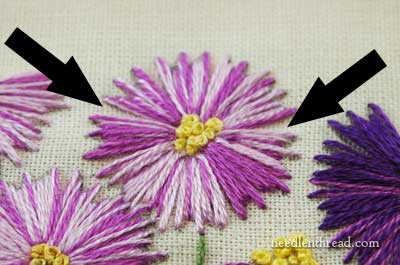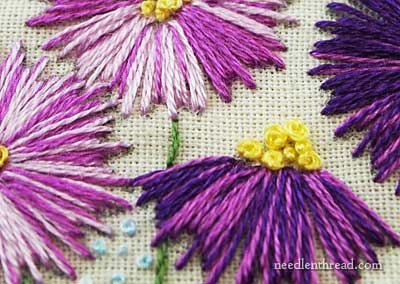Hand embroidery does not have to be complicated in order to be effective.
Take, for example, the under-rated, under-estimated, under-valued, plain-old-every-day straight stitch.
The straight stitch is exactly what it sounds like: a straight stitch. It is the most basic stitch. You bring your needle up in the fabric at some point, and you take it down at another point, pull your thread through, and voilá! You have a straight stitch.
You can’t get more basic than that!

But see? Straight stitch can be quite effective! By fanning out straight stitches from a center point and making their outer edge a bit jagged, you can create a nice embroidered flower.
Use a variegated embroidery floss or an over-dyed embroidery floss, and you have easy and instant color variation!

Notice there’s no real regularity in those flowers. The stitches aren’t meant to be smooth and packed close together, like they would be if you were using satin stitch.
They fan out. There are splits between clumps of the straight stitches. And that’s good – it makes them look more realistic.

If you don’t have any variegated floss, or you don’t like the lack of color control that comes with variegated threads, work with three or so shades of a color (lights and darks of the same color, and a mid-tone, too).
Alternate the use of light and dark in some of your flowers, and mid-tones and dark in others, and mid-tones and lights in others (and maybe all three in still others!).
Sometimes, alternate your thread colors in stitches right next to each other, or work several stitches in one shade and then throw in a couple stitches in another shade. Be a bit random around the flower, and you’ll get a more realistic result.
Clump together some French knots in the middle of your straight stitch flower.
And then add a stem stitch stem and a some fishbone stitch leaves, and you’re good to go!
Simple, effective, basic hand embroidery – who says needlework has to be complicated?







Hi Mary,
What a tease; I would have loved to have seen the full picture in this blog.
It’s a KISS moment …. Keep It Simple Stupid 🙂
And Simple looks SO effective. Love the shading of the colours. Thanks for sharing 🙂
simply beautiful!
G’day Mary,
These are delightful. Just the thing for the granddaughters skirts, shirt pockets etc. I’ll do some when she can watch and maybe help a little too. She is quite dexterous with her hands and fingers already. Some on her dolls clothes or blankets would be interesting for her.
She’s going to be a right brained individual. We were out there for her 2nd birthday and I wrote the number 2 for her on a plain piece of paper. She said it was a nose! Her right brain often comes to the fore but that one has intrigued me the most.
After we came back I showed my parents. Mum could see it as a nose straight away but Dad couldn’t until I put the rest of the face around it. Interesting isn’t it.
Cheers, Kath
PS, My granddaughter is the only, and may be the only, grandchild so I unashamedly claim bragging rights! Thanks for listening.
Hello Mary,
Lovely flowers… I was showing some black work to my sister and she wanted to learn embroidery and… not being a teacher and being a beginner I was tickle to see todays article. I will show her how to do some simple
stitches like your flowers, they are beautiful then…blackwork.
Thank you
France from Québec
Dear Mary
Delightful! Such lovely flowers and soooooos beautiful and simple. You inspire me each day how do you think up such wonderful ideas. Again a design to put needle & thread to.
Thanks
Anita
Mary, The flowers are simply perfect. Couls you show the whole project that these flowers are stitched on?
Thanks in advannce,
Sandy
Here you go inspiring us again! These are awesome little flowers that would really give a relaxing experience. So simple and yet so beautiful.
Love your color selections …
Thanks for the eye candy!
Lovely post. It’s always good to remind (me) people of how wonderful the simple and easy things can be. I may have my daughter stitch something along these lines, she’s always asking to do needlework and I only think of the complex. Thank you for the reminder.
I couldn’t agree with you more! While there are all sorts of complex stitches than can look very effective, to me, simple stitches done well are more effective than anything.
Beautiful.
i somehow find this much similar to satin stitch ..i know could be wrong .. but, can you explain?
Hi, Royce – it is more or less satin stitch, but without being concerned with overlapping stitches as they draw closer together at the inside of the circle. Satin stitch usually lies right next to each other, without any kind of overlapping – the result is perfectly smooth. But with these long straight stitches, that smooth finish associated with satin stitch isn’t necessarily required! Hope that helps! ~MC
As soon as I saw this I thought “translate to 2 or 4mm ribbon, and make a really pretty card”.
(or use threads for the card).
I’m giving up making 3 month long projects for my friends – I want to do more of my ‘own’ work in my style, so cards are “the go” for me.
Thankyou 🙂 The explanation on using the different tones and the stitch placing is great.
I’m very pleased to see how well this stitch works with daisy-type flowers because I’ve been thinking for a very long time about embroidering daisies but I didn’t know what stitch to use, whether to embroider along or across the petal etc. Now I know.
I would however think that the fabric must imperatively be mounted on a hoop or frame to avoid puckering. I would also not recommend this stitch for items of clothing because something could easily snag in the long stitches.
Perhaps it would be safer to tie down the long stitches with tiny overcast st, thereby transforming the straight stitch into Bokhara or Romanian couching (depending whether the overcast stitches make a pattern or are randomly sewn.
At least this gives me a lot to think about. There are so many beautiful flowers with narrow radiating petals, and they come in gorgeous colors too.
hola Mary me encanto tu bordado esta precioso, solo es cuestion de jugar con lso colores, y se logran cosas maravillosas y de beun gusto.
saludos desde Aguascalientes Mexico
Simple, yet a thing of beauty.. Could you please post the complete pic.
Just gorgeous, Mary! Thank you for the inspiration and for showing how we can create something beautiful out of something so simple.
Hello Mary,
Thank you very much for a simple design. Have been looking for an idea to fill in a reasonable size area and I think this will work out quite nicely. Regards Julie.
Love these beautiful flowers – this sent me off hunting for some fabric thread and a little time to create my own….
simple but very fetching
I love your work and I love embroidery pieces…..I learned the basics around 5 or 6 years old and have not advanced much beyond that to this day and I’m in my 80s, but I try to buy linens with bold embroidery when I can…..I just love them all….I’m getting the feeling to do embroidery on some of my handmade knitting…..I want to read over everything in your article when I get a chance (for inspiration etc etc)…thanks for being out there…..
🙂 Hi, Francese – I’m glad you’re enjoying Needle ‘n Thread!
Oh my goodness, just yesterday I was thinking I would like something spring-like to embroider. This pattern would be wonderful. Is it posted somewhere?
Hi, Regina – Thanks for asking! I don’t have a pattern for this, but the technique can be used for pretty much any simple flower design.
I love this picture. I have several of Trish Burr’s books but none contain the pattern for this simple one. I wish she would post it online somewhere for us to give it a try.